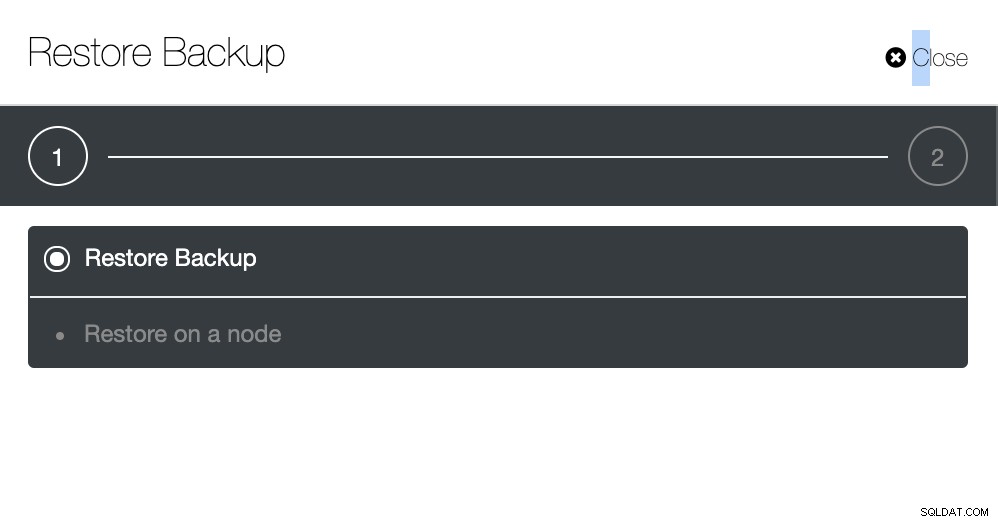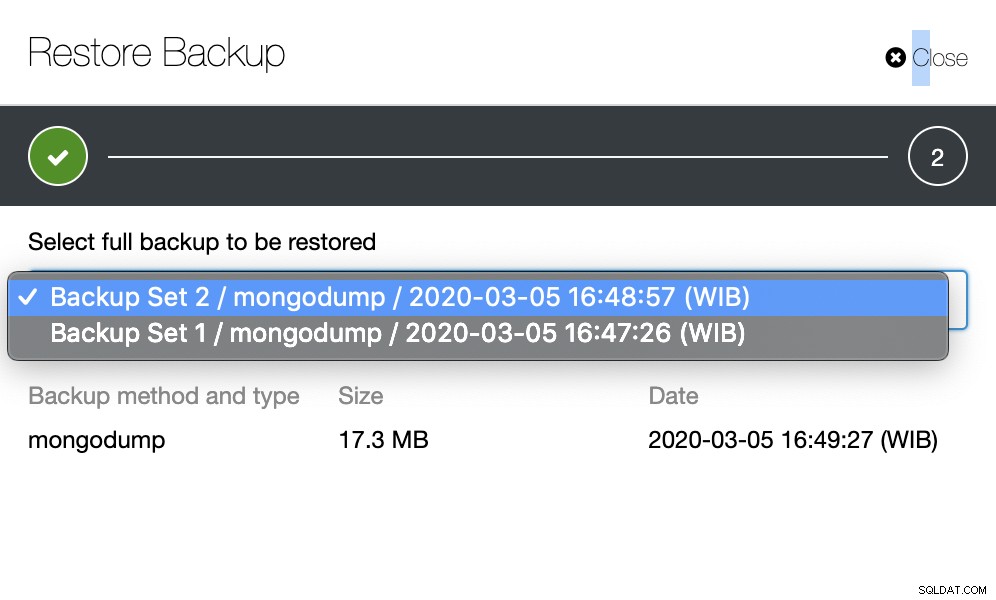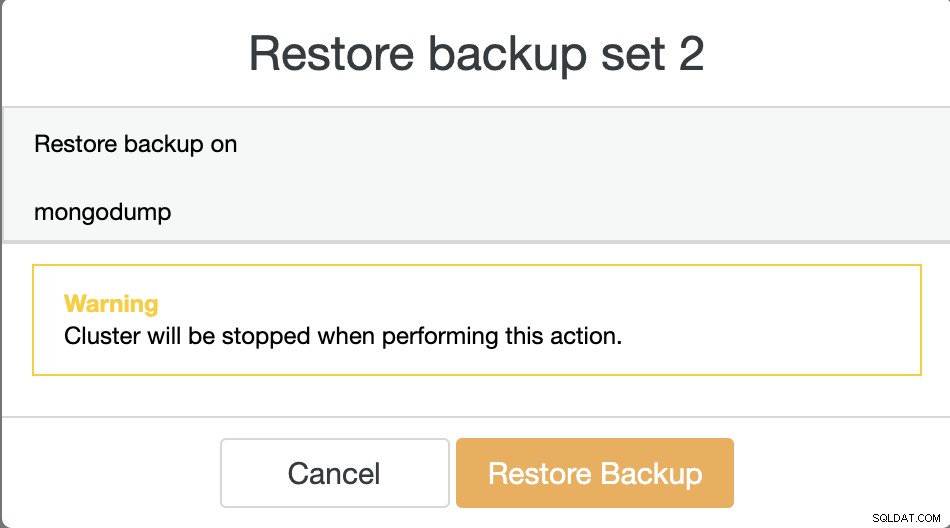Att hålla säkerhetskopior av din databas är en av de viktigaste uppgifterna i alla produktionsmiljöer. Det är processen att kopiera din data till någon annan plats för att hålla den säker. Detta kan vara användbart vid återhämtning från nödsituationer som databaskorruption eller en databas som kraschar bortom reparation.
Förutom återställning kan en säkerhetskopia också användas för att efterlikna en produktionsdatabas för att testa en applikation i en annan miljö, eller till och med för att felsöka något som inte kan göras på produktionsdatabasen.
Det finns olika metoder för säkerhetskopiering av databas som du kan implementera, från logisk säkerhetskopiering med hjälp av verktyg som är inbäddade i databasen (t.ex. mysqldump, mongodump, pg_dump) till fysisk säkerhetskopiering med verktyg från tredje part (t.ex. xtrabackup, barman, pgbackrest, mongodb konsekvent backup).
Vilken metod som ska användas bestäms ofta av hur du vill återställa. Anta till exempel att du tappade ett bord eller en samling av misstag. Hur osannolikt det än kan tyckas händer det. Så det snabbaste sättet att återställa skulle vara att återställa just den tabellen eller samlingen, istället för att behöva återställa en hel databas.
Säkerhetskopiera och återställa i Mongodb
Mongodump och mongorestore är verktyget för logisk säkerhetskopiering som används i MongoDB, det är typ mysqldump i MySQL eller pg_dump i PostgreSQL. Verktyget mongodump och mongorestore kommer att inkluderas när du installerar MongoDB och det dumpar data i BSON-format. Mongodump används för att säkerhetskopiera databasen logiskt till dumpfiler, medan mongorestore används för återställningsoperationen.
mongodump och mongorestore-kommandon är lätta att använda, även om det finns många alternativ.
Som vi kan se nedan kan du säkerhetskopiera specifika databaser eller samlingar. Du kan till och med ta en ögonblicksbild av en tidpunkt genom att inkludera oploggen.
[email protected]:~# mongodump --help
Usage:
mongodump <options>
Export the content of a running server into .bson files.
Specify a database with -d and a collection with -c to only dump that database or collection.
See http://docs.mongodb.org/manual/reference/program/mongodump/ for more information.
general options:
--help print usage
--version print the tool version and exit
verbosity options:
-v, --verbose=<level> more detailed log output (include multiple times for more verbosity, e.g. -vvvvv, or specify a numeric value, e.g. --verbose=N)
--quiet hide all log output
connection options:
-h, --host=<hostname> mongodb host to connect to (setname/host1,host2 for replica sets)
--port=<port> server port (can also use --host hostname:port)
kerberos options:
--gssapiServiceName=<service-name> service name to use when authenticating using GSSAPI/Kerberos ('mongodb' by default)
--gssapiHostName=<host-name> hostname to use when authenticating using GSSAPI/Kerberos (remote server's address by default)
ssl options:
--ssl connect to a mongod or mongos that has ssl enabled
--sslCAFile=<filename> the .pem file containing the root certificate chain from the certificate authority
--sslPEMKeyFile=<filename> the .pem file containing the certificate and key
--sslPEMKeyPassword=<password> the password to decrypt the sslPEMKeyFile, if necessary
--sslCRLFile=<filename> the .pem file containing the certificate revocation list
--sslAllowInvalidCertificates bypass the validation for server certificates
--sslAllowInvalidHostnames bypass the validation for server name
--sslFIPSMode use FIPS mode of the installed openssl library
authentication options:
-u, --username=<username> username for authentication
-p, --password=<password> password for authentication
--authenticationDatabase=<database-name> database that holds the user's credentials
--authenticationMechanism=<mechanism> authentication mechanism to use
namespace options:
-d, --db=<database-name> database to use
-c, --collection=<collection-name> collection to use
uri options:
--uri=mongodb-uri mongodb uri connection string
query options:
-q, --query= query filter, as a JSON string, e.g., '{x:{$gt:1}}'
--queryFile= path to a file containing a query filter (JSON)
--readPreference=<string>|<json> specify either a preference name or a preference json object
--forceTableScan force a table scan
output options:
-o, --out=<directory-path> output directory, or '-' for stdout (defaults to 'dump')
--gzip compress archive our collection output with Gzip
--repair try to recover documents from damaged data files (not supported by all storage engines)
--oplog use oplog for taking a point-in-time snapshot
--archive=<file-path> dump as an archive to the specified path. If flag is specified without a value, archive is written to stdout
--dumpDbUsersAndRoles dump user and role definitions for the specified database
--excludeCollection=<collection-name> collection to exclude from the dump (may be specified multiple times to exclude additional collections)
--excludeCollectionsWithPrefix=<collection-prefix> exclude all collections from the dump that have the given prefix (may be specified multiple times to exclude additional prefixes)
-j, --numParallelCollections= number of collections to dump in parallel (4 by default) (default: 4)
--viewsAsCollections dump views as normal collections with their produced data, omitting standard collectionsDet finns många alternativ i mongorestore-kommandot, obligatoriskt alternativ är relaterat till anslutningsalternativ som värd, port och autentisering. Det finns andra parametrar, som -j används för att återställa samlingar parallellt, -c eller --collection används för en specifik samling och -d eller --db används för att definiera en specifik databas. Listan med alternativ för mongorestore-parametern kan visas med hjälp :
[email protected]:~# mongorestore --help
Usage:
mongorestore <options> <directory or file to restore>
Restore backups generated with mongodump to a running server.
Specify a database with -d to restore a single database from the target directory,
or use -d and -c to restore a single collection from a single .bson file.
See http://docs.mongodb.org/manual/reference/program/mongorestore/ for more information.
general options:
--help print usage
--version print the tool version and exit
verbosity options:
-v, --verbose=<level> more detailed log output (include multiple times for more verbosity, e.g. -vvvvv, or specify a numeric value, e.g. --verbose=N)
--quiet hide all log output
connection options:
-h, --host=<hostname> mongodb host to connect to (setname/host1,host2 for replica sets)
--port=<port> server port (can also use --host hostname:port)
kerberos options:
--gssapiServiceName=<service-name> service name to use when authenticating using GSSAPI/Kerberos ('mongodb' by default)
--gssapiHostName=<host-name> hostname to use when authenticating using GSSAPI/Kerberos (remote server's address by default)
ssl options:
--ssl connect to a mongod or mongos that has ssl enabled
--sslCAFile=<filename> the .pem file containing the root certificate chain from the certificate authority
--sslPEMKeyFile=<filename> the .pem file containing the certificate and key
--sslPEMKeyPassword=<password> the password to decrypt the sslPEMKeyFile, if necessary
--sslCRLFile=<filename> the .pem file containing the certificate revocation list
--sslAllowInvalidCertificates bypass the validation for server certificates
--sslAllowInvalidHostnames bypass the validation for server name
--sslFIPSMode use FIPS mode of the installed openssl library
authentication options:
-u, --username=<username> username for authentication
-p, --password=<password> password for authentication
--authenticationDatabase=<database-name> database that holds the user's credentials
--authenticationMechanism=<mechanism> authentication mechanism to use
uri options:
--uri=mongodb-uri mongodb uri connection string
namespace options:
-d, --db=<database-name> database to use when restoring from a BSON file
-c, --collection=<collection-name> collection to use when restoring from a BSON file
--excludeCollection=<collection-name> DEPRECATED; collection to skip over during restore (may be specified multiple times to exclude additional collections)
--excludeCollectionsWithPrefix=<collection-prefix> DEPRECATED; collections to skip over during restore that have the given prefix (may be specified multiple times to exclude additional prefixes)
--nsExclude=<namespace-pattern> exclude matching namespaces
--nsInclude=<namespace-pattern> include matching namespaces
--nsFrom=<namespace-pattern> rename matching namespaces, must have matching nsTo
--nsTo=<namespace-pattern> rename matched namespaces, must have matching nsFrom
input options:
--objcheck validate all objects before inserting
--oplogReplay replay oplog for point-in-time restore
--oplogLimit=<seconds>[:ordinal] only include oplog entries before the provided Timestamp
--oplogFile=<filename> oplog file to use for replay of oplog
--archive=<filename> restore dump from the specified archive file. If flag is specified without a value, archive is read from stdin
--restoreDbUsersAndRoles restore user and role definitions for the given database
--dir=<directory-name> input directory, use '-' for stdin
--gzip decompress gzipped input
restore options:
--drop drop each collection before import
--dryRun view summary without importing anything. recommended with verbosity
--writeConcern=<write-concern> write concern options e.g. --writeConcern majority, --writeConcern '{w: 3, wtimeout: 500, fsync: true, j: true}'
--noIndexRestore don't restore indexes
--noOptionsRestore don't restore collection options
--keepIndexVersion don't update index version
--maintainInsertionOrder preserve order of documents during restoration
-j, --numParallelCollections= number of collections to restore in parallel (4 by default) (default: 4)
--numInsertionWorkersPerCollection= number of insert operations to run concurrently per collection (1 by default) (default: 1)
--stopOnError stop restoring if an error is encountered on insert (off by default)
--bypassDocumentValidation bypass document validation
--preserveUUID preserve original collection UUIDs (off by default, requires drop)Återställning av specifika samlingar i MongoDB kan göras med hjälp av parametersamlingen i mongorestore. Anta att du har en orderdatabas, inne i orderdatabasen finns det några samlingar som visas nedan:
my_mongodb_0:PRIMARY> show dbs;
admin 0.000GB
config 0.000GB
local 0.000GB
orders 0.000GB
my_mongodb_0:PRIMARY> use orders;
my_mongodb_0:PRIMARY> show collections;
order_details
orders
stockVi har redan schemalagt en backup för orderdatabasen och vi vill återställa lagersamlingen till en ny databas order_new på samma server. Om du vill använda option --collection måste du skicka samlingsnamnet som parameter för mongorestore eller så kan du använda alternativet --nsInclude={db}.{collection} om du inte angav sökvägen till samlingsfilen .
[email protected]:~/dump/orders# mongorestore -umongoadmin --authenticationDatabase admin --db order_new --collection stock /root/dump/orders/stock.bson
Enter password:
2020-03-09T04:06:29.100+0000 checking for collection data in /root/dump/orders/stock.bson
2020-03-09T04:06:29.110+0000 reading metadata for order_new.stock from /root/dump/orders/stock.metadata.json
2020-03-09T04:06:29.134+0000 restoring order_new.stock from /root/dump/orders/stock.bson
2020-03-09T04:06:29.202+0000 no indexes to restore
2020-03-09T04:06:29.203+0000 finished restoring order_new.stock (1 document)
2020-03-09T04:06:29.203+0000 doneDu kan kontrollera samlingen i order_new databasen som visas nedan:
my_mongodb_0:PRIMARY> use order_new;
switched to db order_new
my_mongodb_0:PRIMARY> show collections;
stockHur vi kan återställa med mongodump i ClusterControl
Att återställa en säkerhetskopieringsdump via ClusterControl är enkelt, du behöver bara två steg för att återställa säkerhetskopian. Det kommer att finnas massor av säkerhetskopior i listan om du aktiverat ditt säkerhetskopieringsschema, det finns en del information om säkerhetskopiorna som kan vara mycket användbar. Till exempel status för säkerhetskopiering som indikerar om säkerhetskopieringen slutfördes/misslyckades, säkerhetskopieringsmetoden hade tagits, lista över databaser och storleken på dumpen. Stegen för att återställa MongoDB-data via ClusterControl är enligt nedan:
Steg ett
Följ anvisningarna för att återställa säkerhetskopian till en nod som visas nedan...

Steg två
Du måste välja vilken säkerhetskopia som behöver återställas.

Steg tre
Granska sammanfattningen...

